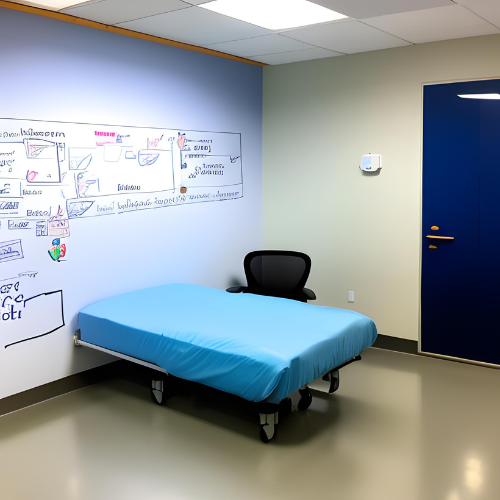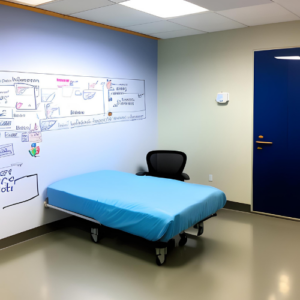Choosing the Best Dry Erase Wall for Medical Facilities
Effective communication, streamlined workflows, and efficient coordination among healthcare professionals are paramount in the fast-paced and critical healthcare environment. Medical facilities increasingly turn to innovative solutions, such as dry erase walls, to meet these unique challenges. This comprehensive guide serves healthcare professionals and facility managers, highlighting the benefits of using the best dry erase wall in healthcare settings and providing detailed recommendations on selecting the best options that meet the specific needs of medical facilities.
Understanding the Benefits of Dry Erase Painted Walls in Healthcare
1. Enhanced Patient Communication
Effective communication is crucial in healthcare, especially when conveying important information to patients, their families, and the healthcare team. Dry erase painted walls provide a visible and easily accessible platform for healthcare providers to communicate vital signs, treatment plans, medication schedules, and other essential details. By utilizing the best dry erase walls, healthcare professionals can improve patient understanding, engagement, and involvement in their care.
Dry erase painted walls can also serve as a communication tool for patients to express their needs, preferences, or questions. This interactive approach actively empowers patients to participate in their healthcare journey and promotes a patient-centered care model.
2. Streamlined Workflow Management
Organizing and monitoring complex workflow in healthcare facilities is paramount to quality patient care. Dry erase walls provide a simple yet highly effective way of managing such daunting tasks. Medical staff can use wall-mounted boards to monitor the progress of individual patients, update schedules daily, assign tasks among clinicians, and conveniently display vital information.
Each team member or department has their designated zone for clarity and visual aid—making it easy to keep track of patient status, document detailed care plans, and pinpoint key reminders and deadlines. In this manner, dry erase painted walls are a powerful tool in streamlining processes, reducing risks of errors, and optimizing workflow management in medical settings.
3. Improved Team Collaboration
In healthcare, successful treatment of patients requires the collective efforts of a multidisciplinary team. To foster smooth collaboration between team members, dry erase walls provide an interactive platform for healthcare professionals to share ideas and discuss effective treatment plans. This visual medium encourages active participation and promotes creative problem-solving.
Dry erase painted walls are a valuable asset in promoting efficient team meetings. They allow professionals to connect and communicate in real-time, encouraging open dialogue and stimulating innovative thinking. With better collaboration and an empowering work setting, these walls can significantly enhance team performance and improve patient care.
4. Enhanced Privacy and Security
In healthcare, protecting patient information is of utmost importance. When selecting the best dry erase wall for medical facilities, it is crucial to consider options that ensure patient privacy and data security. Look for walls with opaque surfaces or the ability to lock sensitive information behind transparent protective sheets. These measures help maintain patient confidentiality while providing a visible and accessible communication platform.
Additionally, some offer customizable privacy options, such as fading or erasing information after a specified time. This feature ensures that confidential patient information does not remain visible for an extended period, further enhancing privacy and security in healthcare settings.
5. Durability and Cleanability
Medical facilities require surfaces that can withstand frequent use, cleaning, and disinfection. When selecting the best dry erase wall, choosing options made from durable materials that can withstand the rigors of a healthcare environment is essential. Consider walls with non-porous surfaces that resist staining and ghosting, as these properties ensure longevity and maintain clear visibility.
Furthermore, easy cleanability is essential to maintain a hygienic environment. Look for dry erase painted walls that can be easily wiped clean without leaving residue or requiring harsh chemicals. Maintaining a clean and germ-free surface contributes to infection control practices and promotes patient safety.
6. Visual Aid for Staff Training and Education
Dry erase walls can be valuable tools during staff training and educational sessions. These walls provide a large surface area for visual aids, illustrations, and diagrams that facilitate the explanation of complex medical concepts, procedures, or protocols. The interactive nature of a dry erase wall allows for real-time updates, ensuring that information is up-to-date and easily accessible during training sessions.
7. Promoting Infection Control
In healthcare environments, infection control is of utmost importance. Dry erase painted walls that are resistant to staining and ghosting and easy to clean and disinfect contribute to maintaining a hygienic environment. The ability to wipe away markings and ensure a clean surface supports infection control practices, reducing the risk of cross-contamination and promoting patient safety.
8. Supporting Quality Improvement Initiatives
Dry erase walls can significantly influence quality improvement initiatives within medical facilities. Staff can use them to display performance metrics, track progress toward goals, or visualize improvement projects. By visually representing data and progress, dry erase painted walls encourage accountability, transparency, and engagement among healthcare professionals, fostering a culture of continuous improvement.
Selecting the Best Dry Erase Wall for Medical Facilities:
1. Surface Quality and Erasability
To ensure a positive user experience, examine the surface quality and erasability of the dry erase wall options. Look for surfaces that provide a smooth writing experience, minimal ghosting, and easy erasability without leaving behind marker residue. These factors contribute to clear visibility and legibility of information, supporting effective communication and collaboration in healthcare settings.
2. Compatibility with Different Surfaces
Consider the compatibility with various surfaces commonly found in medical facilities. Look for options that can be installed on different wall types, including painted walls, smooth surfaces, and even glass. This flexibility allows healthcare facilities to utilize dry erase walls in various areas, such as patient rooms, conference rooms, or nursing stations, based on their specific needs.
3. Installation and Maintenance
Evaluate the installation process and maintenance requirements of different dry erase wall options. Seek walls that are easy to install through adhesive backing or mounting hardware. Additionally, consider the maintenance needs, such as the frequency of cleaning and the availability of replacement markers or erasers. Opting for low-maintenance solutions saves time and resources while ensuring the longevity of the dry erase painted walls.
4. Cost and Long-Term Value
While considering the initial cost, assessing the long-term value they provide is essential. Look for durable options with extended warranties or guarantees to ensure longevity. Additionally, weigh the benefits of improved communication, streamlined workflows, and enhanced collaboration against the investment in such walls. Investing in high-quality options that meet your needs will result in long-term value and a positive return on investment.
5. Ease of Customization
Consider the options for customizing the dry erase walls to meet the specific needs of your healthcare facility. Look for walls that allow for easy customization by adding grids, charts, or templates relevant to your workflows and processes. This feature enhances organization, clarity, and efficiency in communicating information across different departments or teams within the facility.
6. Size and Layout Flexibility
Evaluate the available sizes and layout options of the dry erase walls. Consider the space available within your facility and choose walls that can be customized to fit specific dimensions or seamlessly combined to create larger writing surfaces. This flexibility allows for optimal utilization of available space and ensures that the walls align with the layout of your medical facility.
7. Integration with Technology
Assess the compatibility of the dry erase painted walls with technology tools commonly used in healthcare settings. Look for options that allow for integrating projectors, interactive displays, or digital devices, enabling seamless interaction between physical and digital information. This integration can enhance presentations, education sessions, and collaborative work, providing a comprehensive information sharing and engagement solution.
Conclusion:
Integrating dry erase walls into medical facilities brings innovation, efficiency, and improved communication to healthcare environments. By understanding the benefits of these walls for patient communication, workflow management, and team collaboration, healthcare professionals and facility managers can make informed decisions when selecting the best dry erase wall options. Consider factors such as enhanced patient communication, streamlined workflow management, improved team collaboration, enhanced privacy and security, durability, and cleanability, surface quality and erasability, compatibility with different surfaces, installation and maintenance requirements, and cost and long-term value. By incorporating these considerations into the decision-making process, medical facilities can choose the best dry erase painted wall solution that meets their unique needs and enhances the overall healthcare experience for patients and healthcare professionals.



Recent Comments